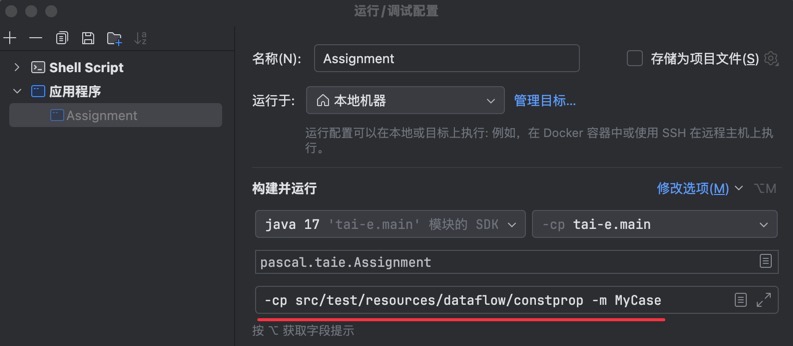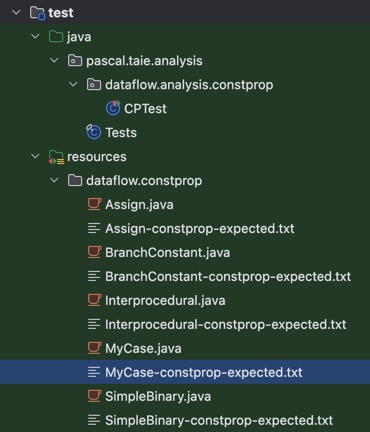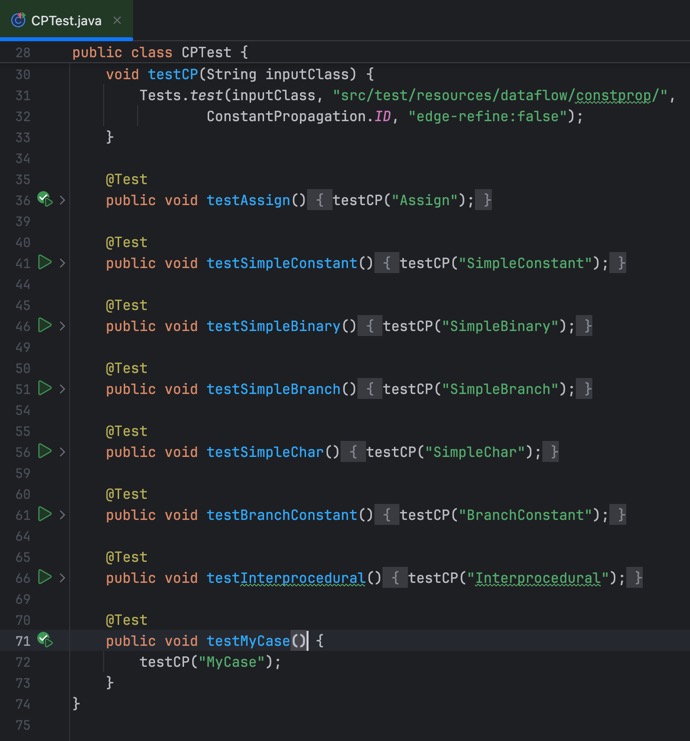本页目录
【程序分析】南京大学软件分析Lab2(常量传播)易错样例补充
NJU程序分析常量传播的Lab在仓库的测试用例中给出的都是比较简单的例子,有一些易错情况没有包括。这个Lab通过率比较低,自己也参考了一些博客改了几次才过OJ,因此这里把一些易错的样例整理出来,便于调试。
易错情况
方法参数的初始化:要初始化成NAC,见作业文档。
对应的测试方法:WithParameter
非整型:此Lab只考虑整型的变量,注意在初始化以及transferNode中判断左值时,要用canHoldInt判断下。
对应的测试方法:CantHoldInt
左值不是Var类型:即便判断一条语句stmt是DefinitionStmt类型,stmt.getLValue()也不一定返回Var类型,比如函数调用语句(Invoke)的左值可能为null(如果没有变量接收返回值),对类的成员变量赋值左值类型为InstanceFieldAccess。
对应的测试方法:LvalNonVar
非二元表达式:比如单目运算符取反,此Lab不考虑,按照NAC处理。
对应的测试方法:OtherExpression
除零:除零和模零规定结果为UNDEF,见作业文档。
对应的测试方法:DivisionByZero
测试样例
MyCase.java:
class MyCase {
private int m;
void WithParameter(int x) {
int a = x;
if (a < 0) {
a = 0;
}
}
void CantHoldInt() {
double a = 3.14;
a += 1;
}
void LvalNonVar() {
int a = 3;
this.m = a;
}
void OtherExpression() {
int a = 3;
int b = -a;
}
void DivisionByZero(int nac) {
int a = nac / 0;
int b = a % 0;
int c = 3 / 0;
}
}
MyCase-constprop-expected.txt:
-------------------- <MyCase: void <init>()> (constprop) --------------------
[0@L1] invokespecial %this.<java.lang.Object: void <init>()>(); {}
[1@L1] return; {}
-------------------- <MyCase: void WithParameter(int)> (constprop) --------------------
[0@L6] a = x; {a=NAC, x=NAC}
[1@L7] %intconst0 = 0; {%intconst0=0, a=NAC, x=NAC}
[2@L7] if (a < %intconst0) goto 4; {%intconst0=0, a=NAC, x=NAC}
[3@L7] goto 6; {%intconst0=0, a=NAC, x=NAC}
[4@L7] nop; {%intconst0=0, a=NAC, x=NAC}
[5@L8] a = 0; {%intconst0=0, a=0, x=NAC}
[6@L8] nop; {%intconst0=0, a=NAC, x=NAC}
[7@L8] return; {%intconst0=0, a=NAC, x=NAC}
-------------------- <MyCase: void CantHoldInt()> (constprop) --------------------
[0@L13] a = 3.14; {}
[1@L14] %doubleconst0 = 1.0; {}
[2@L14] a = a + %doubleconst0; {}
[3@L14] return; {}
-------------------- <MyCase: void LvalNonVar()> (constprop) --------------------
[0@L18] a = 3; {a=3}
[1@L19] %this.<MyCase: int m> = a; {a=3}
[2@L19] return; {a=3}
-------------------- <MyCase: void OtherExpression()> (constprop) --------------------
[0@L23] a = 3; {a=3}
[1@L24] b = -a; {a=3, b=NAC}
[2@L24] return; {a=3, b=NAC}
-------------------- <MyCase: void DivisionByZero(int)> (constprop) --------------------
[0@L28] %intconst0 = 0; {%intconst0=0, nac=NAC}
[1@L28] a = nac / %intconst0; {%intconst0=0, nac=NAC}
[2@L29] b = a % %intconst0; {%intconst0=0, nac=NAC}
[3@L30] %intconst1 = 3; {%intconst0=0, %intconst1=3, nac=NAC}
[4@L30] c = %intconst1 / %intconst0; {%intconst0=0, %intconst1=3, nac=NAC}
[5@L30] return; {%intconst0=0, %intconst1=3, nac=NAC}
使用方法
单独运行
创建src/test/resources/dataflow/constprop/MyCase.java,然后如图修改运行配置:

可以参考以应用软件的形式运行 Tai-e。这种方法需要手动比对输出结果。
单元测试
将MyCase.java和MyCase-constprop-expected.txt都放到src/test/resources/dataflow/constprop目录下:

然后编辑src/test/java/pascal/taie/analysis/dataflow/analysis/constprop/CPTest.java,加入代码:
@Test
public void testMyCase() {
testCP("MyCase");
}

运行测试:
./gradlew clean test